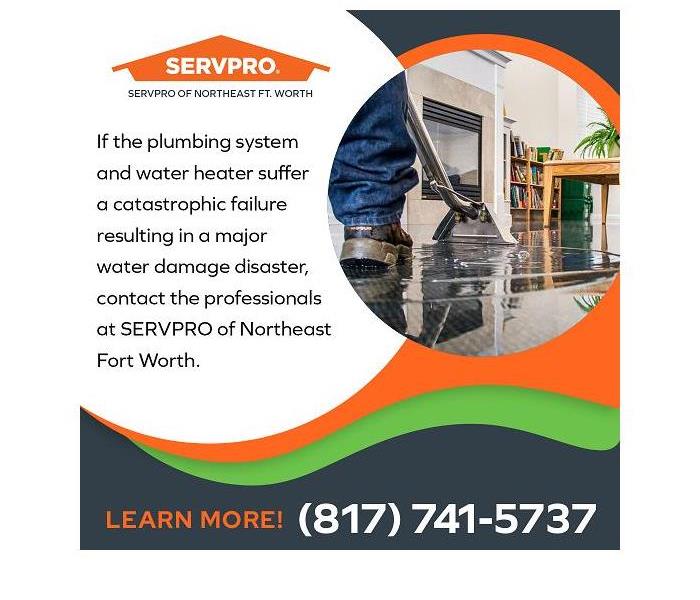How adding a water heater expansion tank can help homeowners mitigate leaks and water damage
1/18/2023 (Permalink)
Blog Summary: SERVPRO® of Northeast Fort Worth is committed to helping homeowners mitigate a water damage disaster. One way to lower the home's water damage risk is installing an expansion tank to relieve excess water in the plumbing system.
The team at SERVPRO of Northeast Fort Worth provides water removal, water damage cleanup, and water damage restoration services if the excessive water pressure in the home causes a catastrophic failure of the home’s plumbing system, including the water heater and other water-using appliances. To help keep the house dry and safe, the SERVPRO team explains how an expansion tank can aid in preventing water heater leaks and water damage in River Trails, Fort Worth, TX, homes.
When the water heater functions correctly, the homeowner enjoys a stream of hot water from the faucet or showerhead. When water heats up, it gets hot, undergoes thermal expansion, and increases in volume, consequently taking up more space. Hot water can cause a buildup of pressure in the hot water system, and this thermal expansion can lead to serious problems. However, water also expands when it freezes! There are ways to solve these problems and prevent pipes from leaking or bursting. A certified plumber can install an expansion tank to protect the home, plumbing, and appliances from thermal expansion.
How can a closed plumbing system lead to trouble?
Increasingly, homes have a device installed on the supply line to prevent the backflow of contaminated household water into the public water system. This backflow preventer, check valve, or pressure-reducing valve is often installed at the water meter. When correctly installed, the device preserves the purity and safety of a community’s drinking water supply.
The power of water pressure
High water pressure is common in a municipal water system. The water system must service tall buildings while providing an adequate water flow through fire hydrants. The elevated water pressure can cause leaks and sometimes a pipe burst. The solution is simple and inexpensive. A pressure-reducing valve can keep the system safe and the home or crawl space dry. The pressure-reducing valve transforms the plumbing into a closed system, and thermal expansion puts the entire system at risk of catastrophic failure. If left alone, the plumbing system becomes a vulnerability that must not be ignored.
Expansion tanks explained
Most people with a well know what an expansion tank is and does. An expansion tank for a hot water system protects not only the water heater but also the washer, dishwasher, and plumbing system. Installing a pressure regulator reduces water pressures to a safe level, but it does not resolve potential risks arising from thermal expansion. The only solution is the installation of an expansion tank.
The expansion tank takes care of the expansion in the plumbing system. The thermal expansion causes an increased volume of hot water, and the water heater can only hold so much. When the water in the heater expands, the excess water enters the expansion tank. The high pressure in the water heater is relieved, preventing a catastrophic failure and keeping the home or business safe from a water damage disaster.
How to detect a water pressure problem
The homeowner can test the water pressure in the home plumbing system by purchasing an inexpensive water pressure gauge at many hardware or big box home supply stores. The gauge screws on an outdoor faucet. The gauge will register the water pressure when the tap is turned on. A pressure reading above 80 psi may indicate a problem with the pressure-reducing valve. Contact a certified plumber to inspect the system and make recommendations to resolve any issues. If needed, the plumber can replace the pressure-reducing valve and adjust it to accommodate the homeowner's needs.
When to install a water expansion tank
A functioning pressure regulator heightens the need to install an expansion tank to protect the home’s plumbing system and water-using appliances from the damaging effects of thermal expansion. Keeping the water pressure within safe limits can extend the water heater's life. The size of the expansion tank is determined by the plumbing system's water pressure and the water heater's capacity. A plumbing professional can make recommendations and provide competent installation of the unit.
The installation of backflow preventers effectively protects public water systems from contamination. However, backflow preventers have increased the risk of damage to the home’s plumbing system and water heater. In response to this elevated risk hazard, some water heater manufacturers require that a water expansion tank be installed along with the new water heater. Failure to take this step may void the manufacturer’s water heater warranty.
How to handle a water damage disaster
If the plumbing system and water heater suffer a catastrophic failure resulting in a major water damage disaster, contact the SERVPRO of Northeast Fort Worth professionals to remove the water, repair any damage to the structure, and restore any salvageable contents in the home. The team at SERVPRO of Northeast Fort Worth provides a rapid response and quick cleanup 24/7, 365 days a year, including holidays.
For more information about Fort Worth, TX, water removal, email SERVPRO of Northeast Fort Worth at office@SERVPROnortheastftworth.com or call (817) 741-5737.





 24/7 Emergency Service
24/7 Emergency Service
